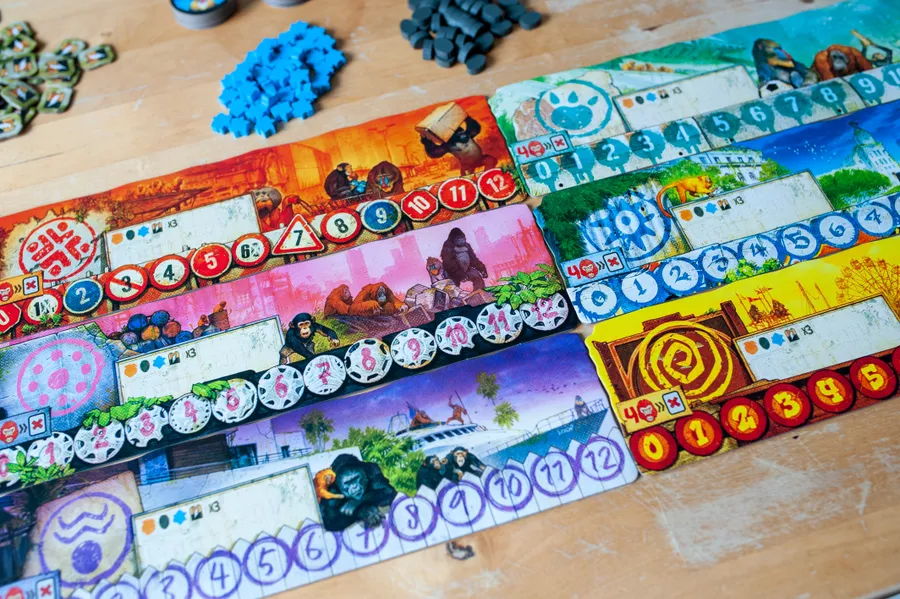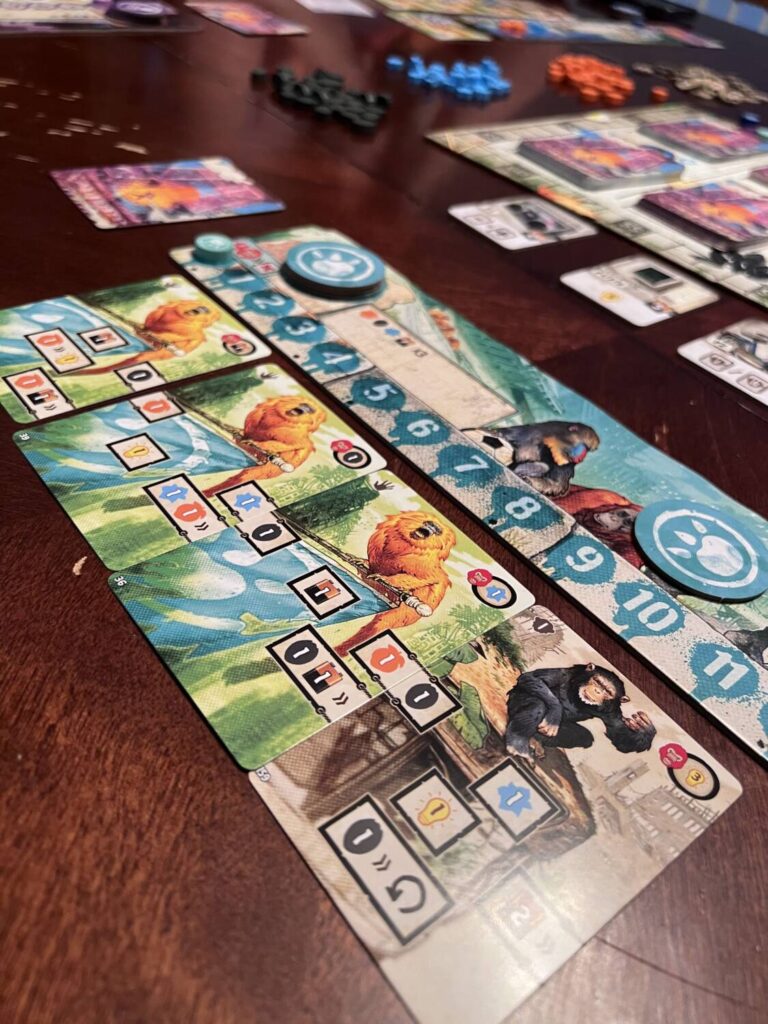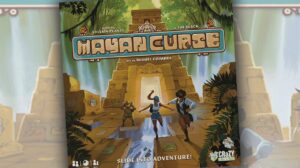Disclosure: Meeple Mountain received a free copy of this product in exchange for an honest, unbiased review. This review is not intended to be an endorsement.
Monkey Mayhem
The year is 2083. The last humans died out forever ago, and the Earth has continued to grow and thrive. Fruits, grains, and various flora have continued to flourish, giving way to a whole new ecosystem to support the growth and evolution of apes. Broken-down electronic objects lost their power a long time ago, but you can bet with a couple of new batteries, that old Nokia phone will still work. This is the strange yet beautiful world in which After Us drops us. Players take on the role of competing tribes of apes trying to strike out and establish dominance by being the first to 80 points in this brave new world.
After Us is a deckbuilder, with some familiar setpieces for fans of the genre. At the start of the game, every player’s tribe consists of eight tamarins, from which each player draws four and assembles them in a tableau in front of them. These cards can be moved around and placed in any order. Each card has several “frames” on it—most of the time, these are partial frames that continue off to the right or left side of the card. By lining up these open frames between cards, players can “close” them off, thereby gaining the benefits contained within the frames. This is all done simultaneously, which keeps the game moving at a brisk pace. Once players have assembled their frames, they can begin collecting the benefits listed on them from left to right, one row at a time. The top row of these cards generally gives you resources, the middle row allows you to exchange some resources for victory points, and the bottom row typically enables ape-specific abilities.

After players have resolved their tableau, phase two begins. During this phase, players will choose one of their four action discs to use for the round and place it face down in front of them. After everyone has selected their action, all players reveal their choices. This action disc has two important features: it gives you a one-time bonus listed on the disc itself, which your neighbors can pay two resources to copy, and it also enables you to attract a new ape to your tribe (read: buy a new card for your deck). There are four types of apes you can attract with different specialties, and you can grab them at level one or level two. Orangutans give you energy, which is a specific resource used to activate a series of objects that are randomly determined at the game start and give you extra actions you can take. Chimpanzees let you reactivate frames from your tableau to gain more resources or victory points. Gorillas generate rage, which is the resource that allows you to trash cards from your deck. Finally, mandrills are your victory point engines, featuring more points than other cards but usually requiring a hefty resource tax to gain them. Once you’ve selected, you put that ape on top of your deck. Everyone resets their board, and the next round begins.
Every Frame a Painting
After Us has gorgeous artwork brought to you by none other than Vincent Dutrait, whose art has been making a splash in the board game space with popular titles like Heat: Pedal to the Metal, Jaipur, and many more. Painstaking detail has been put into the design here, and it all flows together well with a definite aesthetic that carries between the components. Each player board is bright and vibrant across six different colors, each depicting a totally different landscape where each tribe lives. For example, the Red tribe has taken over an old highway, so the board incorporates traffic signage into its visual design, while the Yellow tribe has set up shop at an old amusement park, so their board uses carnival game signage. Each starting deck of eight tamarin cards has the player’s colors woven into the artwork itself rather than using obvious iconography. The resource tokens are chunky, bright wooden pieces that are fun to shuffle around. The physical box itself is just gorgeous, with extra care taken to extend the artwork inside of the box. It’s all quite lovely and really enhances the fiction of the game. I can see and feel the world of After Us everywhere I look.

It’s a little disappointing, then, that all the artwork on the ape cards is the same. There are four different apes and two different levels for each, plus the starting tamarins, so there are nine unique depictions of the apes. The world is so rich and beautiful, it’s a shame that they did not take the time to extend that beauty to the ape cards. Similarly puzzling is the decision to make the energy resource tokens flat cardboard tokens with a Duracell battery on them. The fruit, grain, and flower resources are so wonderful with their bright wooden textures that they make the energy resources stick out like a sore thumb by comparison.
The game features absolutely no text on the cards, and the apes themselves are not thematically flavored. There are some light connections, such as the gorillas being the ones to create rage, but for the most part, the game lives in the world of the abstract. It’s all about the vibe, so when the art is given the attention to detail it deserves, it really shines. But it’s also why the shortcomings feel more pronounced.
Line ‘Em Up
The core gameplay of After Us is centered wholly around the tableau-building phase, or “Primate Assembly” as the game calls it. It is a completely unique experience where you’re solving an optimization puzzle by trying to connect the frames on your cards in the best way possible. This involves a ton of shuffling and reorganizing as you think through frame by frame, line by line, and card by card. How can you ensure you have enough of one specific resource to nab that higher-cost level two card? Can you build a tableau where the second row lets you create optimal exchange rates to refund yourself the resource costs? Can you hit big and sneak in 20 victory points in one go? These questions are the most thrilling part of the game, for sure.

Everything built around this core mechanic is just fine. As a deck-builder, there don’t seem to be many interesting choices to make. In a traditional deck builder, you’re buying cards to add to your deck based on a specific strategy or synergy, which in turn completely changes how your deck plays out. In the case of Dune: Imperium, the core deck-building mechanic has a profound impact on the worker placement mechanic. In After Us, the deck-building seems coincidental. All the decks you’re buying from are facedown on the main board, so the interesting choices stop and end with which of the four types of apes you want to add to your deck. Furthermore, your choice of which ape to add is limited to the tamarin cards you drew. If you want to go for the mandrills but didn’t draw any cards that give you flowers needed to buy them, tough. You’ll have to spring for one of the other apes instead.
Beyond that, even if you could see the front side of the cards before you bought them, it’s way too much information to process to try to make any sort of informed choice. The frame positioning and layout are so different card-to-card that it may as well be random. Not once did I pick up a new card, look at it, and think to myself, “Wow, just what I needed!” I simply glanced at it, shrugged, and put it on top of my pile, ready to get to the phase of the game that’s actually thrilling and engaging where I can try to assemble my lineup.
Closing Thoughts
I really adore the art, design, and world of After Us. It’s a cool theme–one that takes the idea of the apocalypse and somehow makes it feel happy. The core mechanic of assembling frames to generate resources is neat, and I feel there’s some unexplored design space with this kind of jigsaw puzzle mechanic that could really make some waves in the board game world. It’s a bit of a letdown that the mechanics built around the tableau-building don’t hold up to much scrutiny. If After Us is a birthday cake, the frame assembly is the sweet sponge in the center, and the deck building is the fondant wrapped over the top of it, making the whole experience less enjoyable.
However, despite my misgivings about the deck-building mechanisms, After Us will be a game that keeps hitting our table repeatedly for one simple reason: playtime. With turns happening simultaneously, the game moves at an absurdly brisk pace. If everyone understands the rules and knows how to play, it’s reasonable to get a game completed in roughly 20 minutes or so, despite the box’s 40-60-minute label. In this way, the deck building becomes less of an obstruction because you’re breezing past it and spending most of your time with the fun frame building instead. It’s a great filler game that scales well all the way from one player up to a full table of six, and every collection can always use one of those.












Until I read this review, I had no idea this game existed. Your review is very good and has me really wanting to seek out a copy to try. Your review also gives me pause: I want to try a couple of games of this before I fork over any hard-earned cash on this one.
Thanks for a great review.